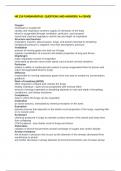Examen
NR 224 FUNDAMENTALS QUESTIONS AND ANSWERS/ A+ GRADE Oxygen necessary to sustain life cardiac and respiratory systems supply O2 demands of the body blood is oxygenated through ventilation, perfusion, and transport neural and chemical regulators control
- Grado
- Institución
NR 224 FUNDAMENTALS QUESTIONS AND ANSWERS/ A+ GRADE Oxygen necessary to sustain life cardiac and respiratory systems supply O2 demands of the body blood is oxygenated through ventilation, perfusion, and transport neural and chemical regulators control rate and depth of respiration Struct...
[Mostrar más]



